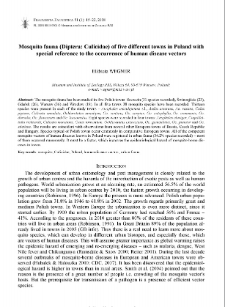- Wyszukaj w całym Repozytorium
- Piśmiennictwo i mapy
- Archeologia
- Baza Młynów
- Nauki przyrodnicze
Wyszukiwanie zaawansowane
Wyszukiwanie zaawansowane
Wyszukiwanie zaawansowane
Wyszukiwanie zaawansowane
Wyszukiwanie zaawansowane

Obiekt
Tytuł: Mosquito fauna (Diptera: Culicidae) of five different towns in Poland with special reference to the occurence of human disease vectors
Inny tytuł:
Fragmenta Faunistica, vol. 51, no. 1 ; Mosquito fauna (Diptera: Culicidae) of five towns in Poland ; Fauna komarów (Diptera: Culicidae) pięciu miast Polski ze szczególnym uwzględnieniem występowania w miastach gatunków będących wektorami chorób ludzi
Współtwórca:
Polska Akademia Nauk. Muzeum i Instytut Zoologii
Wydawca:
Museum and Institute of Zoology, PAS
Miejsce wydania:
Opis:
Bibliogr. s. 21-22 ; S. 15-22 : il. ; 25 cm ; Streszcz. pol. Nazwy taksonów również łac.
Typ obiektu:
Abstrakt:
W pięciu miastach Polski zarejestrowano 38 gatunków komarów (Diptera: Culicidae): w Szczecinie - 31 gatunków, w Świnoujściu - 23, w Gdańsku - 26, w Warszawie - 36 i we Wrocławiu - 18 gatunków. We wszystkich pięciu miastach występuje 13 z nich: Anopheles maculipennis s.l., Aedes vexans, Ae. cinereus, Culex pipiens, Culiseta annulata, Ochlerotatus communis, Oc. cataphylla, Oc. leucomelas, Oc. cantans, Oc. annulipes, Oc. flavescens, Oc. caspius i Oc. dorsalis. W 4 miastach stwierdzono: An. claviger, Coquillettidia richiardii, Oc. geniculatus, Oc. excrucians, Oc. sticticus, Oc. punctor, Cs. morsitans and Cx. torrentium.Wszystkie gatunki komarów będące skutecznymi wektorami chorób ludzi występujące w Polsce zanotowane były w miastach (stanowiły 34,2% fauny miast, przy czym większość z nich występuje w dużych liczebnościach). Jest to z pewnością czynnik istotnie zwiększający ryzyko zachorowania na choroby transmisyjne przenoszone przez komary w miastach w porównaniu do terenów pozamiejskich.
Czasopismo/Seria/cykl:
Tom:
Zeszyt:
Strona pocz.:
Strona końc.:
Szczegółowy typ zasobu:
Format:
Identyfikator zasobu:
oai:rcin.org.pl:45097 ; 10.3161/00159301FF2008.51.1.015
Źródło:
MiIZ PAN, sygn. patrz sygn. czas. P. 256 vol. 51 no. 1 ; MiIZ PAN, sygn. patrz sygn. czas. P. 4664 vol. 51 no. 1 ; kliknij tutaj, żeby przejść
Język:
Język streszczenia:
Prawa:
Prawa zastrzeżone - dostęp nieograniczony
Zasady wykorzystania:
Digitalizacja:
Muzeum i Instytut Zoologii Polskiej Akademii Nauk
Lokalizacja oryginału:
Biblioteka Muzeum i Instytutu Zoologii PAN
Dofinansowane ze środków:
Program Operacyjny Innowacyjna Gospodarka, lata 2010-2014, Priorytet 2. Infrastruktura strefy B + R ; Unia Europejska. Europejski Fundusz Rozwoju Regionalnego
Dostęp:
Kolekcje, do których przypisany jest obiekt:
- Repozytorium Cyfrowe Instytutów Naukowych > Kolekcje Partnerów > Muzeum i Instytut Zoologii PAN > Czasopisma
- Repozytorium Cyfrowe Instytutów Naukowych > Kolekcje Partnerów > Muzeum i Instytut Zoologii PAN > Wydawnictwa MiIZ PAN > Fragmenta Faunistica
- Repozytorium Cyfrowe Instytutów Naukowych > Piśmiennictwo > Czasopisma/Artykuły
Data ostatniej modyfikacji:
4 lut 2025
Data dodania obiektu:
13 maj 2014
Liczba pobrań / odtworzeń:
1645
Wszystkie dostępne wersje tego obiektu:
https://rcin.org.pl./publication/54175
Wyświetl opis w formacie RDF:
Wyświetl opis w formacie RDFa:
Wyświetl opis w formacie OAI-PMH:
Obiekty Podobne
Wegner, Elżbieta
Wegner, Elżbieta Polska Akademia Nauk. Muzeum i Instytut Zoologii
Wegner, Elżbieta Polska Akademia Nauk. Instytut Zoologii
Wegner, Elżbieta
Mikołajczyk, Waldemar (1936–2021)
Mikołajczyk, Waldemar (1936–2021)
Mikołajczyk, Waldemar

 INSTYTUT ARCHEOLOGII I ETNOLOGII POLSKIEJ AKADEMII NAUK
INSTYTUT ARCHEOLOGII I ETNOLOGII POLSKIEJ AKADEMII NAUK
 INSTYTUT BADAŃ LITERACKICH POLSKIEJ AKADEMII NAUK
INSTYTUT BADAŃ LITERACKICH POLSKIEJ AKADEMII NAUK
 INSTYTUT BADAWCZY LEŚNICTWA
INSTYTUT BADAWCZY LEŚNICTWA
 INSTYTUT BIOLOGII DOŚWIADCZALNEJ IM. MARCELEGO NENCKIEGO POLSKIEJ AKADEMII NAUK
INSTYTUT BIOLOGII DOŚWIADCZALNEJ IM. MARCELEGO NENCKIEGO POLSKIEJ AKADEMII NAUK
 INSTYTUT BIOLOGII SSAKÓW POLSKIEJ AKADEMII NAUK
INSTYTUT BIOLOGII SSAKÓW POLSKIEJ AKADEMII NAUK
 INSTYTUT CHEMII FIZYCZNEJ PAN
INSTYTUT CHEMII FIZYCZNEJ PAN
 INSTYTUT CHEMII ORGANICZNEJ PAN
INSTYTUT CHEMII ORGANICZNEJ PAN
 INSTYTUT FILOZOFII I SOCJOLOGII PAN
INSTYTUT FILOZOFII I SOCJOLOGII PAN
 INSTYTUT GEOGRAFII I PRZESTRZENNEGO ZAGOSPODAROWANIA PAN
INSTYTUT GEOGRAFII I PRZESTRZENNEGO ZAGOSPODAROWANIA PAN
 INSTYTUT HISTORII im. TADEUSZA MANTEUFFLA POLSKIEJ AKADEMII NAUK
INSTYTUT HISTORII im. TADEUSZA MANTEUFFLA POLSKIEJ AKADEMII NAUK
 INSTYTUT JĘZYKA POLSKIEGO POLSKIEJ AKADEMII NAUK
INSTYTUT JĘZYKA POLSKIEGO POLSKIEJ AKADEMII NAUK
 INSTYTUT MATEMATYCZNY PAN
INSTYTUT MATEMATYCZNY PAN
 INSTYTUT MEDYCYNY DOŚWIADCZALNEJ I KLINICZNEJ IM.MIROSŁAWA MOSSAKOWSKIEGO POLSKIEJ AKADEMII NAUK
INSTYTUT MEDYCYNY DOŚWIADCZALNEJ I KLINICZNEJ IM.MIROSŁAWA MOSSAKOWSKIEGO POLSKIEJ AKADEMII NAUK
 INSTYTUT PODSTAWOWYCH PROBLEMÓW TECHNIKI PAN
INSTYTUT PODSTAWOWYCH PROBLEMÓW TECHNIKI PAN
 INSTYTUT SLAWISTYKI PAN
INSTYTUT SLAWISTYKI PAN
 SIEĆ BADAWCZA ŁUKASIEWICZ - INSTYTUT TECHNOLOGII MATERIAŁÓW ELEKTRONICZNYCH
SIEĆ BADAWCZA ŁUKASIEWICZ - INSTYTUT TECHNOLOGII MATERIAŁÓW ELEKTRONICZNYCH
 MUZEUM I INSTYTUT ZOOLOGII POLSKIEJ AKADEMII NAUK
MUZEUM I INSTYTUT ZOOLOGII POLSKIEJ AKADEMII NAUK
 INSTYTUT BADAŃ SYSTEMOWYCH PAN
INSTYTUT BADAŃ SYSTEMOWYCH PAN
 INSTYTUT BOTANIKI IM. WŁADYSŁAWA SZAFERA POLSKIEJ AKADEMII NAUK
INSTYTUT BOTANIKI IM. WŁADYSŁAWA SZAFERA POLSKIEJ AKADEMII NAUK




































